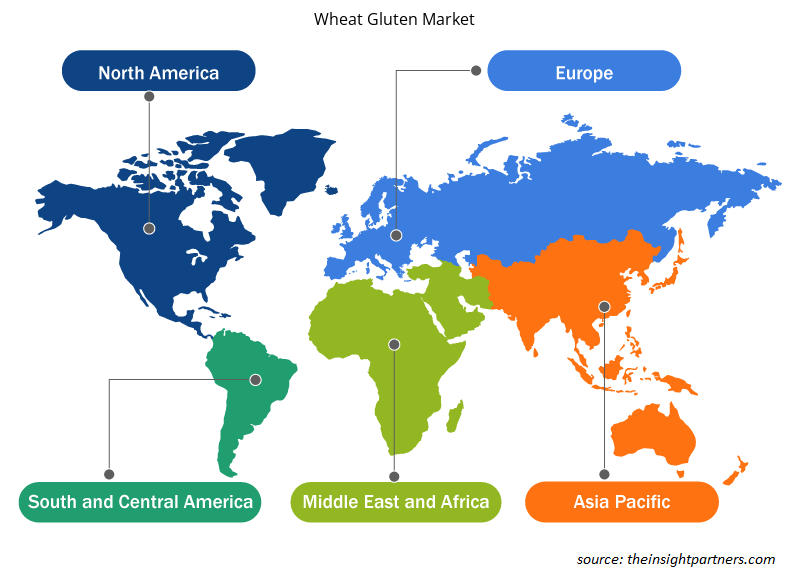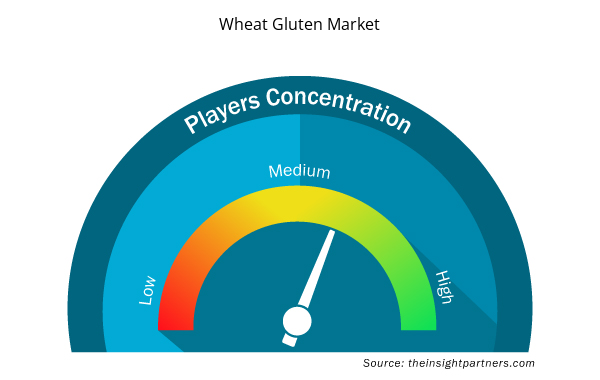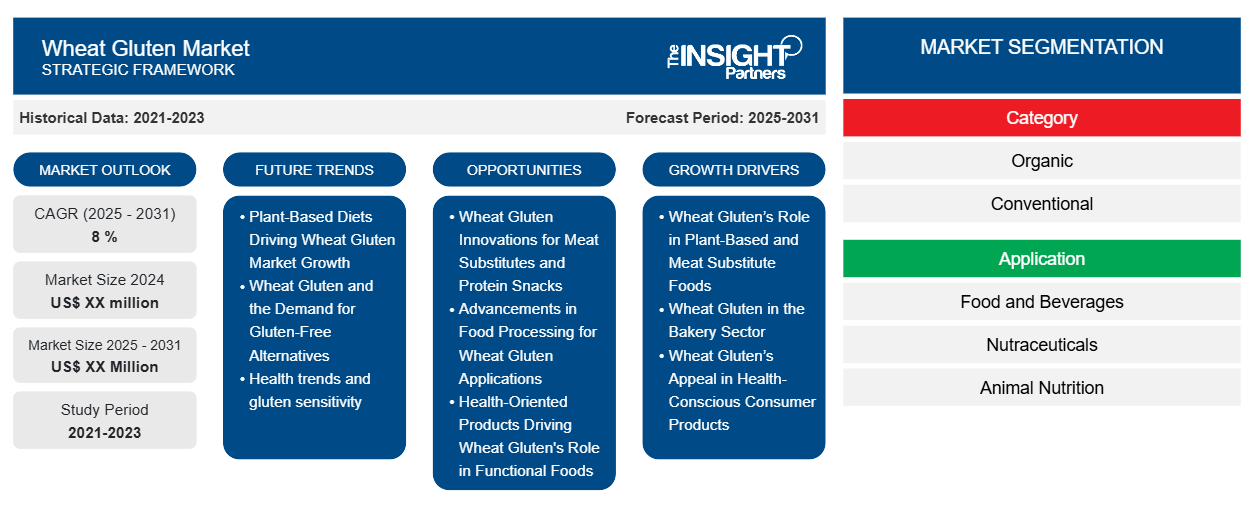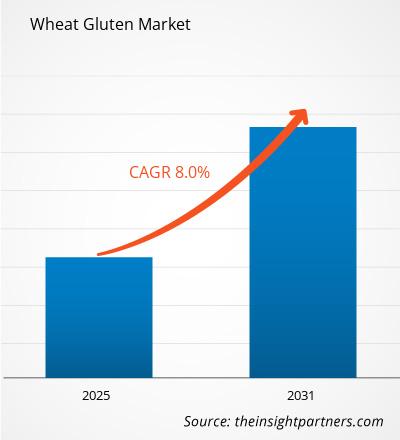Si prevede che il mercato del glutine di frumento registrerà un CAGR dell'8% dal 2023 al 2031, con una dimensione di mercato in espansione da XX milioni di dollari USA nel 2023 a XX milioni di dollari USA entro il 2031.
Il rapporto è segmentato per categoria (biologico, convenzionale). Il rapporto presenta inoltre analisi basate sull'applicazione (cibo e bevande, nutraceutici, nutrizione animale, altri). L'analisi globale è ulteriormente suddivisa a livello regionale e nei principali paesi. In termini geografici, il mercato è suddiviso in Nord America, Europa, Asia Pacifico, Medio Oriente e Africa e Sud e Centro America). Il rapporto offre il valore in USD per l'analisi e i segmenti di cui sopra.
Scopo del rapporto
Il report Wheat Gluten Market di The Insight Partners mira a descrivere il panorama attuale e la crescita futura, i principali fattori trainanti, le sfide e le opportunità. Ciò fornirà spunti a vari stakeholder aziendali, come:
- Fornitori/produttori di tecnologia: per comprendere le dinamiche di mercato in evoluzione e conoscere le potenziali opportunità di crescita, consentendo loro di prendere decisioni strategiche informate.
- Investitori: condurre un'analisi completa delle tendenze in merito al tasso di crescita del mercato, alle proiezioni finanziarie del mercato e alle opportunità esistenti lungo la catena del valore.
- Enti di regolamentazione: regolamentano le politiche e le attività di controllo sul mercato allo scopo di ridurre al minimo gli abusi, preservare la fiducia degli investitori e sostenere l'integrità e la stabilità del mercato.
Segmentazione del mercato del glutine di frumento
Categoria
- Organico
- Convenzionale
Applicazione
- Cibo e bevande
- Nutraceutici
- Nutrizione animale
- Altri
Personalizza questo report in base alle tue esigenze
Riceverai la personalizzazione gratuita di qualsiasi report, comprese parti di questo report, o analisi a livello nazionale, pacchetto dati Excel, oltre a usufruire di grandi offerte e sconti per start-up e università
- Scopri le principali tendenze di mercato in questo rapporto.Questo campione GRATUITO includerà analisi di dati che spaziano dalle tendenze di mercato alle stime e alle previsioni.
Fattori trainanti della crescita del mercato del glutine di frumento
- Ruolo del glutine di grano negli alimenti a base vegetale e sostituti della carne: la crescente tendenza verso gli alimenti all'ingrosso orientati alle piante sta aumentando i requisiti di fornitura di glutine di grano, che è ricco di proteine ed è versatile nell'uso. Poiché i consumatori sono alla ricerca di sostituti della carne, il glutine di grano è ora utilizzato in molti modi, tra cui sotto forma di sostituti della carne e snack ricchi di proteine, il che aiuta nella crescita del mercato.
- Glutine di frumento nel settore della panificazione: a favorire la crescita del mercato del glutine di frumento è il settore della panificazione, che utilizza il glutine per migliorare la consistenza e l'elasticità dell'impasto. Con l'aumento del consumo pro capite di pane e altri prodotti da forno in tutto il mondo, si prevede che la richiesta di glutine di frumento crescerà, favorendo così la crescita del suo mercato.stretchability of dough. With the increase in the per capita consumption of bread and other baked products around the world, the requirement for wheat gluten is projected to grow, thereby aiding its market growth.
- L'attrattiva del glutine di grano nei prodotti di consumo attenti alla salute: c'è un notevole aumento della consapevolezza della salute delle persone; quindi, c'è una propensione a cercare risorse dietetiche che siano funzionali in natura. Poiché il glutine di grano è una ricca fonte di proteine e fibre, c'è stato un cambiamento per sviluppare prodotti più attenti alla salute che a loro volta forniscono nuovi cambiamenti positivi nel mercato.
Tendenze future del mercato del glutine di frumento
- Le diete a base vegetale guidano la crescita del mercato del glutine di grano: c'è una crescita considerevole nella tendenza delle diete a base vegetale che guidano il mercato del glutine di grano per l'uso in sostituti della carne e alimenti arricchiti di proteine. Tuttavia, tale sviluppo è una risposta al cambiamento di atteggiamento del mercato nei confronti di alimenti sani e rispettosi dell'ambiente, ampliando ulteriormente la portata del mercato e guidandone la crescita.
- Glutine di grano e domanda di alternative senza glutine: le persone stanno diventando più consapevoli dei problemi di assistenza sanitaria correlati al glutine, che si tratti di celiachia o intolleranza al glutine, il che rende facile definire il mercato di riferimento per i prodotti senza glutine. Questa tendenza influenza l'innovazione e il comportamento dei consumatori dei produttori, portandoli a pensare a modi per produrre prodotti senza glutine e allo stesso tempo produrre prodotti con glutine di grano.
- Tendenze in materia di salute e sensibilità al glutine: le diete senza glutine stanno guadagnando popolarità tra le persone allergiche o sensibili al glutine. Pertanto, i produttori stanno spostando la loro attenzione sullo sviluppo di prodotti con un contenuto di glutine inferiore per i consumatori che cercano prodotti a basso contenuto di glutine.
Opportunità di mercato del glutine di frumento
- Innovazioni del glutine di grano per sostituti della carne e snack proteici: poiché sempre più persone praticano il vegetarianismo, si presenta la domanda di innovazioni alimentari basate sul glutine di grano, in particolare nello sviluppo di sostituti della carne e snack ad alto contenuto proteico. Questo perché è facilmente prodotto in forme così strutturate e contiene un'alta percentuale di proteine, un aspetto che è attraente per i produttori alimentari che mirano a questo gruppo di consumatori.
- Progressi nella lavorazione degli alimenti per applicazioni di glutine di grano: inoltre, gli sviluppi in atto nella lavorazione dell'industria alimentare e le tecnologie all'avanguardia offrono spazio per invenzioni di ulteriori attributi del glutine di grano. Questi potrebbero essere miglioramenti delle composizioni effettive di torte, noodles e così via, che consentiranno ai produttori di adattarsi alle mutevoli richieste del mercato per prodotti alimentari puliti, più sani e funzionali.
- Prodotti orientati alla salute che guidano il ruolo del glutine di grano negli alimenti funzionali: per quanto riguarda la questione della domanda di prodotti alimentari orientati alla salute, il mercato degli alimenti funzionali sta crescendo prevalentemente a causa del cambiamento nel comportamento dei consumatori. Questo anche perché il glutine di grano è una buona fonte di proteine e fibre e quindi potrebbero essere sviluppati più prodotti orientati alla salute, includendolo come materia prima essenziale in linea con le tendenze emergenti in materia di salute.
Approfondimenti regionali sul mercato del glutine di frumento
Le tendenze regionali e i fattori che influenzano il Wheat Gluten Market durante il periodo di previsione sono stati ampiamente spiegati dagli analisti di Insight Partners. Questa sezione discute anche i segmenti e la geografia del Wheat Gluten Market in Nord America, Europa, Asia Pacifico, Medio Oriente e Africa, e Sud e Centro America.

- Ottieni i dati specifici regionali per il mercato del glutine di frumento
Ambito del rapporto sul mercato del glutine di frumento
| Attributo del report | Dettagli |
|---|---|
| Dimensioni del mercato nel 2023 | XX milioni di dollari USA |
| Dimensioni del mercato entro il 2031 | XX milioni di dollari USA |
| CAGR globale (2023-2031) | 8% |
| Dati storici | 2021-2022 |
| Periodo di previsione | 2024-2031 |
| Segmenti coperti | Per categoria
|
| Regioni e Paesi coperti | America del Nord
|
| Leader di mercato e profili aziendali chiave |
|
Densità degli attori del mercato del glutine di frumento: comprendere il suo impatto sulle dinamiche aziendali
Il mercato del glutine di grano sta crescendo rapidamente, spinto dalla crescente domanda degli utenti finali dovuta a fattori quali l'evoluzione delle preferenze dei consumatori, i progressi tecnologici e una maggiore consapevolezza dei benefici del prodotto. Con l'aumento della domanda, le aziende stanno ampliando la loro offerta, innovando per soddisfare le esigenze dei consumatori e capitalizzando sulle tendenze emergenti, il che alimenta ulteriormente la crescita del mercato.
La densità degli operatori di mercato si riferisce alla distribuzione di aziende o società che operano in un particolare mercato o settore. Indica quanti concorrenti (operatori di mercato) sono presenti in un dato spazio di mercato in relazione alle sue dimensioni o al valore di mercato totale.
Le principali aziende che operano nel mercato del glutine di frumento sono:
- Bryan W Nash e figli Ltd
- Cargill, Incorporata
- Kroener Staerke
- Loryma GmbH
- Ingredienti MGP
Disclaimer : le aziende elencate sopra non sono classificate secondo un ordine particolare.

- Ottieni una panoramica dei principali attori del mercato del glutine di grano
Punti di forza chiave
- Copertura completa: il rapporto esamina in modo completo i prodotti, i servizi, le tipologie e gli utenti finali del mercato del glutine di frumento, offrendo una panoramica olistica.
- Analisi degli esperti: il rapporto è compilato sulla base della conoscenza approfondita di esperti e analisti del settore.
- Informazioni aggiornate: il rapporto garantisce la pertinenza aziendale grazie alla copertura di informazioni recenti e tendenze nei dati.
- Opzioni di personalizzazione: questo report può essere personalizzato per soddisfare le esigenze specifiche del cliente e adattarsi in modo appropriato alle strategie aziendali.
Il rapporto di ricerca sul mercato del glutine di grano può quindi aiutare a guidare il percorso di decodificazione e comprensione dello scenario del settore e delle prospettive di crescita. Sebbene possano esserci alcune preoccupazioni valide, i vantaggi complessivi di questo rapporto tendono a superare gli svantaggi.
- Analisi storica (2 anni), anno base, previsione (7 anni) con CAGR
- Analisi PEST e SWOT
- Valore/volume delle dimensioni del mercato - Globale, regionale, nazionale
- Industria e panorama competitivo
- Set di dati Excel



Report Coverage
Revenue forecast, Company Analysis, Industry landscape, Growth factors, and Trends

Segment Covered
This text is related
to segments covered.

Regional Scope
North America, Europe, Asia Pacific, Middle East & Africa, South & Central America

Country Scope
This text is related
to country scope.
Domande frequenti
The report can be delivered in PDF/Word format, we can also share excel data sheet based on request.
Cargill Incorporated, Roquette Frères S.A, Royal Ingredients Group, Pioneer Industries Limited, Permolex Ltd, Z and F Sungold Corporation, Kroener Staerke, Agrana, Sacchetto S.p.A. and Co KG are the key players operating in the market
Based on geography, North America held the largest share of the wheat gluten market.
Significantly growing bakery industry, and rising demand for functional food are the major factors driving the wheat gluten market growth.
Increasing consumer awareness about gluten sensitivity is likely to remain the key trends in the market.
The Wheat Gluten Market is estimated to witness a CAGR of 8 % from 2023 to 2031
Trends and growth analysis reports related to Food and Beverages : READ MORE..
1. Bryan W Nash and Sons Ltd
2. Cargill, Incorporated
3. Kroener Staerke
4. Loryma GmbH
5. MGP Ingredients
6. Nugen Feeds and Foods
7. Pioneer Industries Limited
8. Royal Ingredients Group
9. Sacchetto S.p.A.
10. Tereos S.A.
The Insight Partners performs research in 4 major stages: Data Collection & Secondary Research, Primary Research, Data Analysis and Data Triangulation & Final Review.
- Data Collection and Secondary Research:
As a market research and consulting firm operating from a decade, we have published and advised several client across the globe. First step for any study will start with an assessment of currently available data and insights from existing reports. Further, historical and current market information is collected from Investor Presentations, Annual Reports, SEC Filings, etc., and other information related to company’s performance and market positioning are gathered from Paid Databases (Factiva, Hoovers, and Reuters) and various other publications available in public domain.
Several associations trade associates, technical forums, institutes, societies and organization are accessed to gain technical as well as market related insights through their publications such as research papers, blogs and press releases related to the studies are referred to get cues about the market. Further, white papers, journals, magazines, and other news articles published in last 3 years are scrutinized and analyzed to understand the current market trends.
- Primary Research:
The primarily interview analysis comprise of data obtained from industry participants interview and answers to survey questions gathered by in-house primary team.
For primary research, interviews are conducted with industry experts/CEOs/Marketing Managers/VPs/Subject Matter Experts from both demand and supply side to get a 360-degree view of the market. The primary team conducts several interviews based on the complexity of the markets to understand the various market trends and dynamics which makes research more credible and precise.
A typical research interview fulfils the following functions:
- Provides first-hand information on the market size, market trends, growth trends, competitive landscape, and outlook
- Validates and strengthens in-house secondary research findings
- Develops the analysis team’s expertise and market understanding
Primary research involves email interactions and telephone interviews for each market, category, segment, and sub-segment across geographies. The participants who typically take part in such a process include, but are not limited to:
- Industry participants: VPs, business development managers, market intelligence managers and national sales managers
- Outside experts: Valuation experts, research analysts and key opinion leaders specializing in the electronics and semiconductor industry.
Below is the breakup of our primary respondents by company, designation, and region:

Once we receive the confirmation from primary research sources or primary respondents, we finalize the base year market estimation and forecast the data as per the macroeconomic and microeconomic factors assessed during data collection.
- Data Analysis:
Once data is validated through both secondary as well as primary respondents, we finalize the market estimations by hypothesis formulation and factor analysis at regional and country level.
- Macro-Economic Factor Analysis:
We analyse macroeconomic indicators such the gross domestic product (GDP), increase in the demand for goods and services across industries, technological advancement, regional economic growth, governmental policies, the influence of COVID-19, PEST analysis, and other aspects. This analysis aids in setting benchmarks for various nations/regions and approximating market splits. Additionally, the general trend of the aforementioned components aid in determining the market's development possibilities.
- Country Level Data:
Various factors that are especially aligned to the country are taken into account to determine the market size for a certain area and country, including the presence of vendors, such as headquarters and offices, the country's GDP, demand patterns, and industry growth. To comprehend the market dynamics for the nation, a number of growth variables, inhibitors, application areas, and current market trends are researched. The aforementioned elements aid in determining the country's overall market's growth potential.
- Company Profile:
The “Table of Contents” is formulated by listing and analyzing more than 25 - 30 companies operating in the market ecosystem across geographies. However, we profile only 10 companies as a standard practice in our syndicate reports. These 10 companies comprise leading, emerging, and regional players. Nonetheless, our analysis is not restricted to the 10 listed companies, we also analyze other companies present in the market to develop a holistic view and understand the prevailing trends. The “Company Profiles” section in the report covers key facts, business description, products & services, financial information, SWOT analysis, and key developments. The financial information presented is extracted from the annual reports and official documents of the publicly listed companies. Upon collecting the information for the sections of respective companies, we verify them via various primary sources and then compile the data in respective company profiles. The company level information helps us in deriving the base number as well as in forecasting the market size.
- Developing Base Number:
Aggregation of sales statistics (2020-2022) and macro-economic factor, and other secondary and primary research insights are utilized to arrive at base number and related market shares for 2022. The data gaps are identified in this step and relevant market data is analyzed, collected from paid primary interviews or databases. On finalizing the base year market size, forecasts are developed on the basis of macro-economic, industry and market growth factors and company level analysis.
- Data Triangulation and Final Review:
The market findings and base year market size calculations are validated from supply as well as demand side. Demand side validations are based on macro-economic factor analysis and benchmarks for respective regions and countries. In case of supply side validations, revenues of major companies are estimated (in case not available) based on industry benchmark, approximate number of employees, product portfolio, and primary interviews revenues are gathered. Further revenue from target product/service segment is assessed to avoid overshooting of market statistics. In case of heavy deviations between supply and demand side values, all thes steps are repeated to achieve synchronization.
We follow an iterative model, wherein we share our research findings with Subject Matter Experts (SME’s) and Key Opinion Leaders (KOLs) until consensus view of the market is not formulated – this model negates any drastic deviation in the opinions of experts. Only validated and universally acceptable research findings are quoted in our reports.
We have important check points that we use to validate our research findings – which we call – data triangulation, where we validate the information, we generate from secondary sources with primary interviews and then we re-validate with our internal data bases and Subject matter experts. This comprehensive model enables us to deliver high quality, reliable data in shortest possible time.


 Ottieni un campione gratuito per questo repot
Ottieni un campione gratuito per questo repot